Quando os clientes fazem uma reserva em um restaurante, mas não aparecem sem aviso prévio ou cancelamento, isso é chamado de "no-show".
Essa situação pode ser frustrante e custosa para os estabelecimentos afetados, especialmente aqueles que operam com margens de lucro apertadas.
A não comparecimento dos clientes não apenas resulta em perda de receita, mas também interrompe o fluxo das operações e afeta a experiência geral do cliente.
É por isso que trazemos para você cinco dicas práticas para evitar os não comparecimentos em seu restaurante.
Seja você dono de um restaurante sofisticado ou de um local mais descontraído, essas dicas podem ser aplicadas a qualquer tipo de estabelecimento para minimizar os casos de clientes que não honram suas reservas.
As cinco dicas irão melhorar a eficiência do seu restaurante, aumentar a satisfação dos clientes e maximizar o seu potencial de receita.
Torne a sua Política de Cancelamento Transparente
Pesquisas revelam que impressionantes 70% dos clientes reconhecem o impacto negativo das faltas em restaurantes, mas não estão motivados a tomar medidas para mitigá-las.
No entanto, se eles estivessem cientes de que sua falta de comparecimento acarretaria consequências para si próprios, essas estatísticas certamente mudariam para melhor.
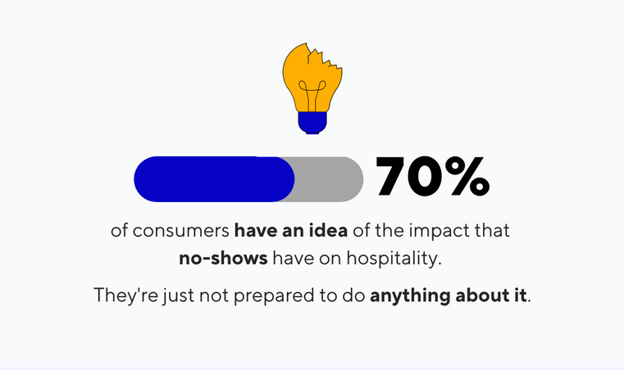
Illustration: Tablein / Data: Zonal
What do we mean by the consequences for customers?
This depends entirely on the restaurant. They could include no-show fees, late cancellation fees, or maybe even blacklisting those who repeatedly fail to show up.
We will come to each of these in a moment, but let’s first see how your restaurant can communicate said repercussions to customers and prompt a shift in their behavior.
The first step is to craft a cancellation policy that leaves no room for ambiguity and is easily accessible to all patrons.
The policy should contain all the necessary information on canceling a reservation and the steps that will be taken if your patrons neglect to do it in time.
Start by prominently displaying your cancellation policy on your website, ensuring it is clearly visible, easily accessible, and not buried in the depths of your site.
Take a cue from The Palomar, a London-based restaurant, which showcases its cancellation policy on the home page, right under Reservations.
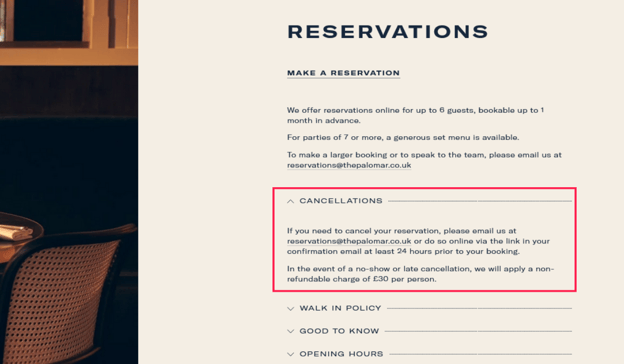
Source: The Palomar
Furthermore, clearly state the deadline by which would-be patrons should cancel their reservations, accompanied by explicit instructions on how to do so.
Following The Palomar's example, you can inform the diners that they can cancel their reservations by email or by clicking the link provided in the confirmation email they received, and emphasize that cancellations should be made at least 24 hours before the reservation time.
By establishing a specific timeframe and providing simple cancellation instructions, you encourage your guests to take responsibility for their reservations and understand the significance of timely cancellations.
To further reinforce the importance of cancellations, outline the consequences of not canceling a reservation within the specified timeframe.
One effective approach is to consider implementing a fee charged to the credit card used for the reservation, as in the case of the Melbourne-based Maha restaurant:

Source: Maha
By clearly communicating these repercussions to customers, you ensure they are more likely to be motivated to cancel rather than simply not showing up and losing their money.
In conclusion, by creating a cancellation policy that is clear, visible, and easily accessible, you empower consumers to make informed decisions and take responsibility for their reservations.
This reduces no-shows and improves your restaurant's overall efficiency and profitability.
Remember, the goal is to guide customers in the right direction, helping them understand why being a no-show is detrimental not only to your business but also to their dining experience.
Ask Customers to Re-Confirm Their Reservation
In addition to the clear cancellation policy, encouraging customers to re-confirm their reservations is another effective way to reduce no-shows and late cancellations.
By requiring customers to respond or take action manually, you create a deliberate step for them to consider their availability, reducing the likelihood of forgetting or overlooking the reservation.
This is an excellent approach considering we know that forgetting they made a reservation is one of the main reasons why customers don't show up in the first place.
However, you can't call each person the day before their reservation to confirm it, can you? That would be highly time-consuming and chaotic, to say the least.
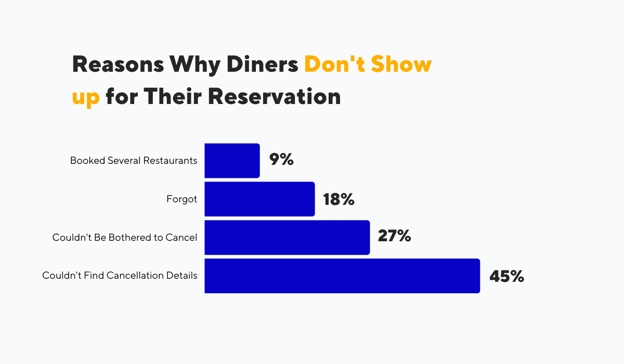
Illustration: Tablein / Data: Carbon Free Dining
So, to implement this approach, it is essential to have a reservation system in place that can automatically send reminder emails to customers a day or two before their scheduled reservation.
These emails should prompt the recipients to re-confirm their reservation if they can attend or provide an option to cancel the reservation if they cannot make it.
Our table booking software, Tablein, is a valuable tool that can assist in this process.
Its re-confirmation email functionality simplifies the process and ensures a smoother experience for restaurant owners and their patrons.
Here's how the re-confirmation feature works.
Once a customer makes a reservation, they receive an email notification confirming that the restaurant has successfully received their booking, as seen in the photo below.
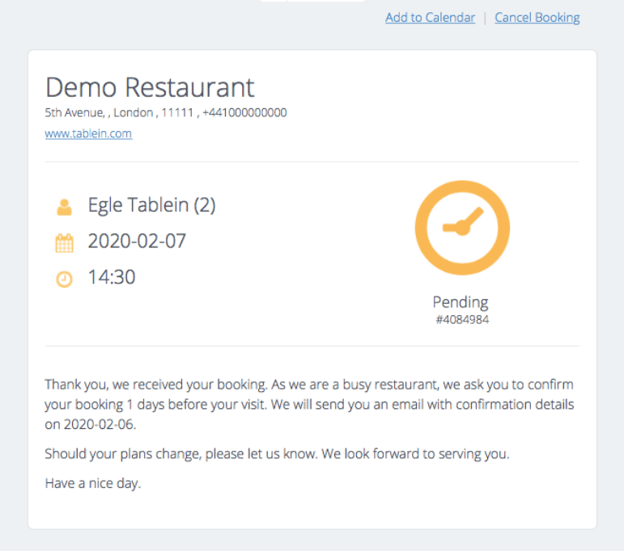
Source: Tablein
To make the process even more convenient, Tablein offers an "Add to calendar" option in the top right corner of the email.
With just a click, patrons can effortlessly add their reservations to their calendars, ensuring they won't miss it.
Then, prior to their scheduled visit (the exact number of days can be determined by the restaurant), the customer will receive another email containing a link.
This link lets them easily confirm their attendance or cancel the reservation if their plans change.
It is as simple as that.
All in all, by implementing a re-confirmation system, you create an additional layer of accountability for consumers, making them actively engage with their reservation and consider their availability.
This simple step can significantly minimize the occurrence of no-shows and allow you to stay on top of your reservations.
Charge Late Cancellation and No-Show Fees
Charging late cancellation and no-show fees is a powerful tool for restaurants to encourage responsible behavior among customers when it comes to honoring their reservations.
By implementing such fees, customers are held financially accountable for their actions, making them more likely to show up or cancel on time.
Still, many restaurants avoid this method, believing they will lose customers because they will choose other restaurants that don’t charge such fees.
But this is a misconception.
In fact, studies show that more than half of customers are willing to pay no-show fees.
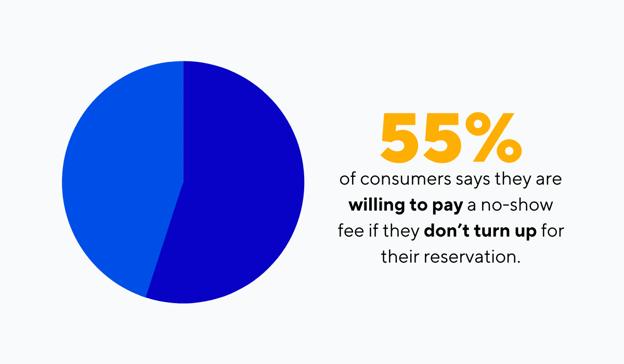
Illustration: Tablein / Data: Zonal
However, to successfully charge these fees, you must communicate your booking policy and display charges in advance.
And as we have already mentioned today, your policy must be clear and well-visible on your website and during the reservation process.
This prevents any surprises for the patrons and sets clear expectations from the start.
To implement the fees effectively, restaurants need a robust reservation system that securely stores customers' card information and enables automatic charging in case of a late cancellation or no-show.
Here's where Tablein can help, offering a seamless feature designed to handle these situations.
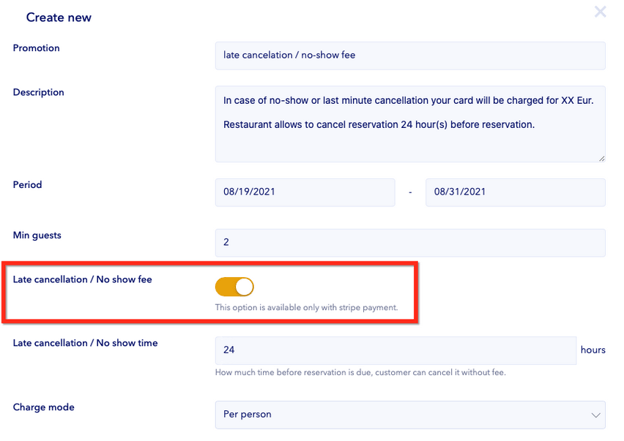
Source: Tablein
Tablein provides a convenient solution for managing late cancellations and no-shows through its integration with the Stripe payment method.
When guests make a reservation, they are prompted to provide their card details.
The user-friendly interface of Tablein ensures that the booking policy is clearly displayed, allowing guests to make an informed decision before confirming their reservation, as shown in the example below.
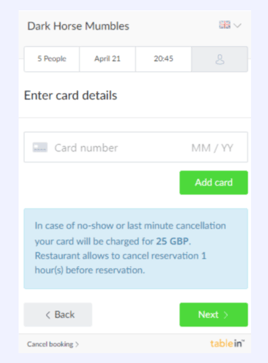
Source: Tablein
To reinforce the importance of honoring reservations, an automatic confirmation email is sent to guests, outlining the no-show and late cancellation policy.
This ensures that guests are aware of the consequences and provides a fair and transparent way to deal with any unpredictable situations.
If guests fail to cancel in time or don’t show up, Tablein's system automatically deducts the applicable fee from the credit card details provided during the booking process.
Overall, by charging late cancellation and no-show fees, restaurants can instill a sense of responsibility in their patrons, ensuring that reservations are honored or canceled on time.
This reduces the financial impact of no-shows on the business and opens up opportunities to accommodate other guests waiting for a table.
Consider Taking Prepaid Reservations for Events
Taking prepaid reservations, also known as tickets, is another strategic approach that restaurants can employ to address the issue of no-shows.
By requiring upfront payment from customers, the likelihood of them honoring their reservation increases significantly. Individuals who have already invested their money are more inclined to follow through with their commitment.
This approach not only helps mitigate the problem of no-shows but also provides financial security for the restaurant by receiving full payment in advance.
For example, Restaurant Gebr-Hartering in Amsterdam successfully implemented prepaid reservations.
Although cautious at the beginning, Niek Hartering, the owner, found that customers were willing to pay for their dining experience upfront, leading to increased attendance and reduced no-shows.
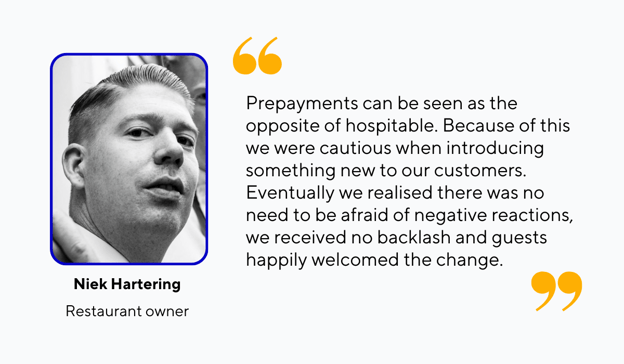
Illustration: Tablein / Data: formitable
Lazy Bear in San Francisco serves as another case study.
Their reservation system relies entirely on nonrefundable but transferable tickets.
So even if a guest cannot attend, the reservation can be easily transferred to someone else, ensuring that the booking does not go to waste.
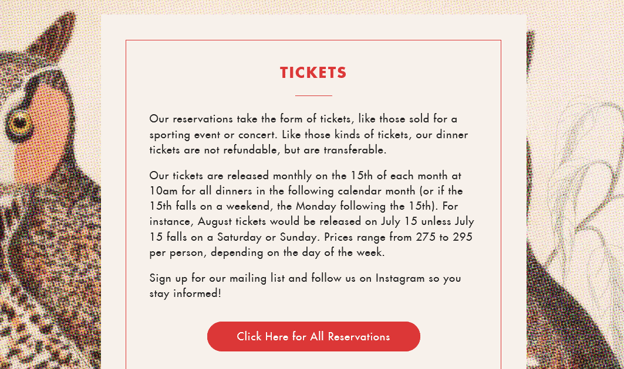
Source: Lazy Bear
However, if fully transitioning to this type of booking seems daunting, your restaurant can still implement them for specific events you organize, such as holiday events, wine-pairing dinners, or themed culinary experiences.
Utilizing comprehensive booking software with a prepayment feature will enable you to do that.
The prepayment feature allows you to create customizable events, for which you can enter detailed descriptions with menu information, event timings, special discounts that might apply, minimum guest requirements, specific areas within the restaurant where the event will be held, and many more.
In summary, prepaid reservations provide restaurants with a reliable and profitable event experience.
They offer financial assurance and no revenue loss, so by organizing events with prepaid reservations, you can effectively address the issue of no-shows—all that while providing a superior experience for your patrons.
Start Tracking Your Frequent No-Shows
The last of our five tips to prevent no-shows is to track and monitor guests who frequently fail to honor their reservations, and even resort to blacklisting them when necessary.
Although it may sound harsh, the unfortunate reality is that no-shows can have a significant financial impact on restaurants.
Heidi Bakewell, the manager of the Welsh restaurant Bryncynan, shared that their establishment lost around £20,000 in just one summer due to no-shows.
This enormous waste is the result of irresponsible customers who simply fail to cancel their reservations and do not show up.
To address this problem, many restaurants and pubs have implemented measures such as black books, no-return policies, or even blacklisting irresponsible diners altogether.
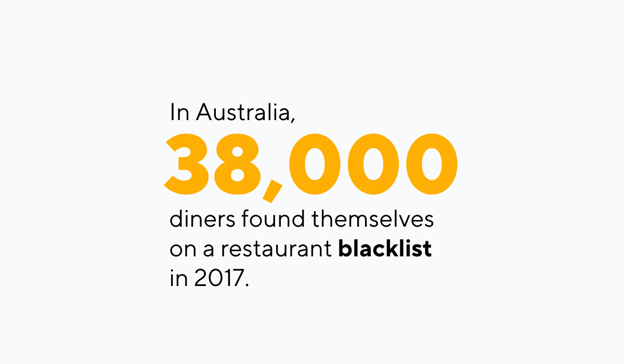
Illustration: Tablein / Data: Broadsheet
For example, approximately 38,000 individuals found themselves on a restaurant blacklist in Australia in 2017 after one online restaurant-booking service introduced a blacklist program allowing restaurateurs to bar customers for up to a year if they consistently fail to show up at the agreed-upon time.
Implementing a tracking system for frequent no-shows can yield positive results.
Recognizing and taking action against repeat offenders who disregard the establishment's policies and repeatedly fail to honor their commitments is essential.
While blacklisting customers should be a last resort, it effectively protects your business and resources.
A robust booking system with reservation sorting features can assist in tracking no-shows, enabling you to identify guests who have repeatedly failed to honor their reservations.
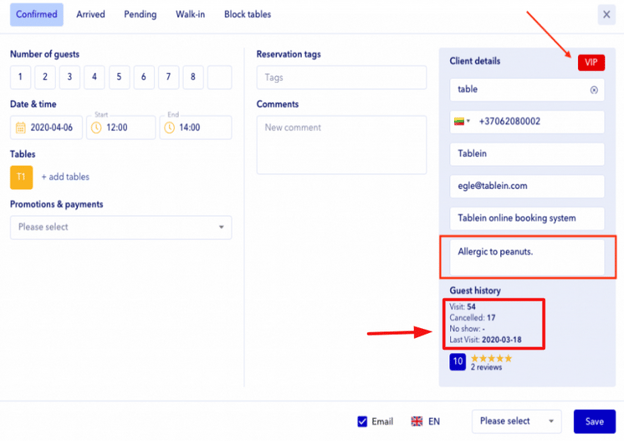
Source: Tablein
Remember, blacklisting should be considered a final option when all other remedies have been exhausted.
You have to protect the interests of your restaurant and ensure a fair and reliable dining experience for all guests.
So, utilize technology and comprehensive booking systems to streamline the tracking process, protect your business, and mitigate the detrimental effects of no-shows.
Conclusion
While no-shows remain an ongoing challenge in the restaurant industry, implementing the tips we discussed and utilizing a robust booking system can go a long way in preventing them.
By establishing a clear cancellation policy, prompting re-confirmation, offering prepayment options, charging fees, and tracking repeat offenders, you can take decisive action to address this issue.
Stay proactive, embrace these tips, and create a dining experience that minimizes the impact of no-shows while maximizing customer satisfaction.
Get a 30-day Exclusive Trial
As a Tablein blog reader, you’re eligible for an exclusive 30-day free trial to experience our simple reservation solution for your restaurant.
Enter your business email, and we’ll send you all the steps needed to create your account.
Share this
You may also like

Maneira fácil de diminuir drasticamente as ausências não lucrativas

Por Que Todo Restaurante Deveria Vender Suas Mesas Online
